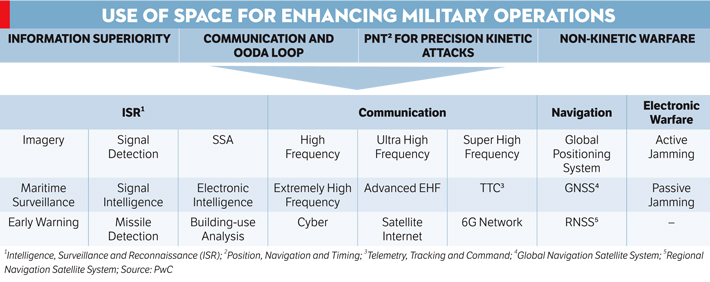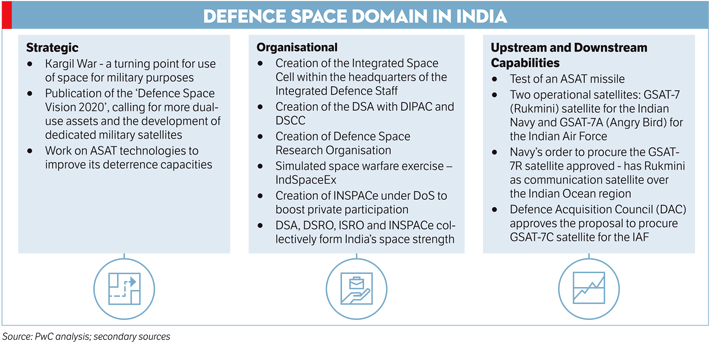INDIAN ARMED FORCES CHIEFS ON
OUR RELENTLESS AND FOCUSED PUBLISHING EFFORTS

SP Guide Publications puts forth a well compiled articulation of issues, pursuits and accomplishments of the Indian Army, over the years

I am confident that SP Guide Publications would continue to inform, inspire and influence.

My compliments to SP Guide Publications for informative and credible reportage on contemporary aerospace issues over the past six decades.
Dual Use Domain
Going ahead, space for defence in terms of technology is as crucial as is defence of space in terms of security and strategies

In an era where the frontier of space exploration transcends scientific boundaries, nations worldwide are grappling with the complexities of space militarisation. India, home to a rapidly evolving space programme, finds itself at a critical juncture, seeking to harness space technology for national security while ensuring peaceful exploration and cooperation. As a nation with diverse security concerns, looking at space militarisation is a strategic imperative. Securing its vast borders, maintaining effective communication, and monitoring potential threats necessitates reinforcing space capabilities. The Kargil conflict in 1999, where access to GPS data was denied, exposed the vulnerabilities of relying on foreign-controlled systems. India responded by stepping up efforts to develop an indigenous navigation system - Navigation with Indian Constellation (NavIC) - ensuring unfettered access to crucial space-based services.
In March 2019, India accomplished an extraordinary feat with Mission Shakti, becoming only the fourth country to test an anti-satellite (A-SAT) weapon system. The successful interception of a live satellite demonstrated India’s ability to neutralise potential threats in space. While the test faced international scrutiny due to space debris concerns, it underscored India’s strategic intent to protect its space assets and deter potential adversaries.
Recognising the significance of space situational awareness (SSA), ISRO launched Project NETRA in September 2019. This ambitious project aims to monitor, track, and analyse space objects to protect Indian satellites from collisions and potential hostile actions. By developing an indigenous SSA capability, India enhances its understanding of space dynamics and ensures uninterrupted access to critical space assets.
In addition to bolstering national security, India’s space endeavors have led to significant advancements in dual-use technologies. The Indian Regional Navigation Satellite System (IRNSS) is a prime example, providing accurate and reliable navigation services to civilians, defence forces, and various sectors of the economy. Such dual-use technologies contribute to India’s overall technological prowess while serving vital defence purposes.
As space emerges as a domain of strategic significance, the space industry in India is adapting to its expanded role in defence and security. Advanced reconnaissance satellites, communication systems, and remote sensing capabilities have been harnessed for defence applications, enhancing India’s intelligence gathering and surveillance capabilities.
In recent times, the convergence of space technology and defence has become more pressing than ever before. Various factors are contributing to this urgency, including the rapid expansion of space infrastructure, increased participation in space activities by nations, evolving geopolitical scenarios, the pursuit of superpower status, and ongoing technological advancements that can potentially disrupt space operations. The utilisation of space technology for military purposes is not a new concept though. For decades, satellite communication, surveillance, weather forecasting, navigation services, and highresolution remote sensing imagery have been integral to military operations. In fact, the exploration of space itself had its origins in military motives with the famous space race between the Soviet Union and the United States during the Cold War. The history of space exploration itself traces back to technologies derived from wartime applications, such as the V2 rockets. This dual-use nature of space technology has existed since its inception, leading to the growing recognition of the significance of integrating defence and space capabilities in modern times.


DEFSPACE
Space has transcended its role as a domain for exploration and socio-economic development. It has become a force multiplier, enabling strategic advantages, and a vital domain for national security. Many space-faring nations are now actively pursuing the militarisation of space and establishing dedicated space forces to address the emerging frontiers of war. India, with its thriving civil space programme, has also recognised the necessity of integrating space and defence efforts. In 2020, the Prime Minister of India launched the DefSpace challenges, marking a significant step toward aligning the space and defence industries. Driven by the vision of Atmanirbhar Bharat with Indian characteristics, the Ministry of Defence (MoD) took this step to leverage the potential of the Indian space industry. The aim is to present challenges that synergise the national technological capability and contribute to DefSpace challenges, involving various stakeholders like the defence forces, tech providers (ISRO, DRDO, industry), academia, and diplomacy. The mission aims to encourage innovative solutions and strengthen the forces, presenting 75 challenges focused on leveraging the innovative potential of the private sector to support national security requirements. The challenges address critical technology gaps, subdivided into component challenges for startups under the guidance of the Defence Space Agency. The focus is on building resilience and redundancy in space-based infrastructure, and space sector reforms, supported by Mission DefSpace, are elevating India’s aspirations in the right orbit. Many of the private startups like Pixxel, InspeCity, etc have won contracts with the Indian Armed Forces. Through initiatives like iDex, DefSPace challenges and events like DefSpace Symposium and DefSat Conference, the tri-services are coming forward to break the silos and collaborate with the industry to make use of the technologies.
The term “DefSpace” refers to the convergence of defence and space capabilities, highlighting the increasing importance of utilising space technology for defence purposes. From the early days of space exploration during the Cold War, military space systems were used for strategic missions, including missile warning, intelligence, and command and control.
Space, with its vast potential and dual-use nature, has been a domain of exploration, security, and commercialisation. Projections indicate that by 2060, 10 per cent of Global GDP may come from space-related activities. As space emerges as the “5th dimension of warfare,” countries are investing in disruptive technologies to bolster national security. Establishing space forces and enhancing space superiority have become crucial components of future military strategy, aligning with land, sea, and air dominations.
Some of the countries with a dedicated defence-related space force include:
- Russian Space Force (2015): Responsible for space-related military operations and defence of Russian space assets.
- China’s PLA Strategic Support Force (2015): Integrating space, cyber, and electronic warfare capabilities to support China’s military objectives.
- The US Space Force (2019): Dedicated to protecting US space assets and ensuring space superiority for national security.
- India’s Defence Space Agency, DSA (2019): Focused on enhancing India’s space capabilities and integrating space into its defence operations.
- French Air and Space Force (2020): Responsible for both air and space operations, ensuring France’s presence and security in space.
- Japan’s Space Operation Squadron (2020): Tasked with space situational awareness and monitoring space debris to ensure secure space operations.
- German Space Command (2021): Responsible for planning, executing, and coordinating space operations to safeguard Germany’s space assets and support national security objectives.
- Australia Defence Space Command, DSpC (2022): Overseeing Australia’s space capabilities and contributing to national defence through space operations.
The transformation of warfare and the militarisation of space are undeniable trends, drawing global attention and concerns. However, the convergence of defence and space industries has become inevitable. India’s space programme originally prioritised socio-economic development, setting it apart from countries with established military space programmes. However, in today’s interconnected world and volatile geopolitical environment, things are moving towards integration. Emerging and disruptive technologies are reshaping the space domain, leading to the emergence of dual-use applications with both commercial and military capabilities. This shift towards commercialisation has blurred the lines between civil and military space activities. While India’s space programme may not be on par with major players like China or the US, it has achieved significant milestones with homegrown spacecraft launch capabilities and a thriving industry supporting remote sensing and Earth observation.
India’s ISRO has successfully launched rockets like GSLV, PSLV, and SSLV, and manufactures diverse payloads, from remote sensing to navigation. Private players like Digantra, Sky Root, and Pixxel have contributed to the nation’s success stories in space exploration. As the space domain becomes more complex, safeguarding national space-based assets becomes crucial. Military users require advanced capabilities, including relaunchable vehicles, nuclear power for interplanetary missions, high-resolution imagery, and resilient satellite communications. Ground infrastructure, space situational awareness, and counter-ASAT capabilities are also essential to ensure national security.
As space technology advances, countries are leveraging space assets for both civil and military purposes, leading to a complex and competitive space domain. The absence of international treaties or binding regulations on space weaponisation poses significant challenges. Additionally, counter-space operations and emerging trends like anti-satellite weapon systems, advanced missiles, high-altitude pseudo-satellites, electronic warfare, and cyber warfare are transforming the dynamics of space warfare.
The military’s requirements in space are expanding, from resilient satellite communications to advanced intelligence, surveillance, and reconnaissance (ISR) capabilities. Ground infrastructure, space situational awareness, and counter-ASAT technologies are crucial for safeguarding space-based assets. To enhance India’s DefSpace capabilities, collaboration between the government and private entities is vital along with a defence space policy, joint space doctrine, and cyber-space integration are needed. As the space domain evolves, governments globally must also adopt holistic strategies, support space start-ups, and promote innovation to navigate the challenges posed by space militarisation. Creating a regulatory framework and nurturing scientific temperament will be crucial for achieving long-term success in this transformative era of space exploration. Going ahead, space for defence in terms of technology is as crucial as is defence of space in terms of security and strategies.





